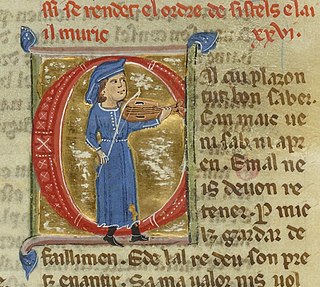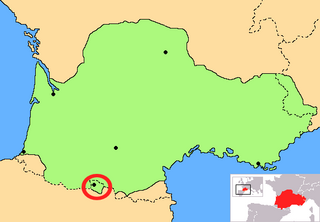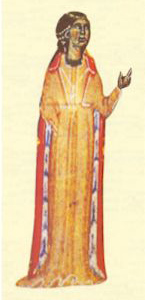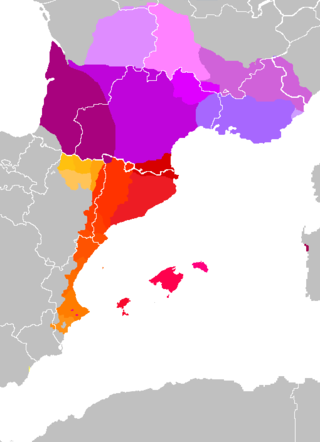Related Research Articles

Occitan, also known as lenga d'òc by its native speakers, sometimes also referred to as Provençal, is a Romance language spoken in Southern France, Monaco, Italy's Occitan Valleys, as well as Spain's Val d'Aran in Catalonia; collectively, these regions are sometimes referred to as Occitania. It is also spoken in Calabria in a linguistic enclave of Cosenza area. Some include Catalan in Occitan, as the linguistic distance between this language and some Occitan dialects is similar to the distance between different Occitan dialects. Catalan was considered a dialect of Occitan until the end of the 19th century and still today remains its closest relative.

A troubadour was a composer and performer of Old Occitan lyric poetry during the High Middle Ages (1100–1350). Since the word troubadour is etymologically masculine, a female equivalent is usually called a trobairitz.

Catalan literature is the name conventionally used to refer to literature written in the Catalan language. The focus of this article is not just the literature of Catalonia, but literature written in Catalan from anywhere, so that it includes writers from Andorra, the Valencian Community, Balearic Islands and other territories where any Catalan variant is spoken.

The music of Catalonia comprises one of the oldest documented musical traditions in Europe. In tandem with the rest of Western Europe, it has a long musical tradition, incorporating a number of different styles and genres over the past two thousand years.

Aranese is a standardized form of the Pyrenean Gascon variety of the Occitan language spoken in the Val d'Aran, in northwestern Catalonia close to the Spanish border with France, where it is one of the three official languages beside Catalan and Spanish. In 2010, it was declared the third official language in Catalonia by the Parliament of Catalonia.

Occitania is the historical region in Southern Europe where the Occitan language was historically spoken and where it is sometimes used as a second language. This cultural area roughly encompasses much of the southern third of France as well as part of Spain, Monaco, and parts of Italy.
The partimen is a cognate form of the French jeu-parti. It is a genre of Occitan lyric poetry composed between two troubadours, a subgenre of the tenso or cobla exchange in which one poet presents a dilemma in the form of a question and the two debate the answer, each taking up a different side. Of the nearly 200 surviving Occitan debate songs, 120 are partimens and 75 are open tensos. The partimen was especially popular in poetic contests. See also Torneyamen.
There have been many languages spoken in the Iberian Peninsula.

The trobairitz were Occitan female troubadours of the 12th and 13th centuries, active from around 1170 to approximately 1260. Trobairitz is both singular and plural.
The sirventes or serventes, sometimes translated as "service song", was a genre of Old Occitan lyric poetry practiced by the troubadours.

Occitano-Romance is a branch of the Romance language group that encompasses the Catalan/Valencian, Occitan languages and sometimes Aragonese, spoken in parts of southern France and northeastern Spain.
La Coupo Santo, in full La Cansoun de la Coupo in original modern norm Provençal is considered the anthem of the Félibrige. It is sung in Provençal, one of six Occitan dialects.
An ensenhamen was an Old Occitan didactic poem associated with the troubadours. As a genre of Occitan literature, its limits have been open to debate since it was first defined in the 19th century. The word ensenhamen has many variations in old Occitan: essenhamen, ensegnamen, enseinhamen, and enseignmen.
The Cançoneret de Ripoll, now manuscript 129 of Ripoll in the Arxiu de la Corona d'Aragó, is a short Catalan-Occitan chansonnier produced in the mid-fourteenth century but after 1346, when Peter IV of Aragon held a poetry competition which is mentioned in the chansonnier. Influenced by Cerverí de Girona, the chansonnier and its ideology serve as transition in the history of Catalan literature between the dominance of the troubadours and the new developments of Ausiàs March.

The Cançóde Santa Fe, a hagiographical poem about Saint Faith, is an early surviving written work in Old Occitan and has been proposed to be the earliest work in Old Catalan. It is 593 octosyllabic lines long, divided into between 45 and 55 monorhyming laisses. It was written between 1054 and 1076, during the reign of Ramon Berenguer I, Count of Barcelona, by an anonymous poet.
Guerau III de Cabrera, also called Guirautde Cabreira, was a Catalan nobleman and Occitan troubadour. He was the viscount of Àger and Cabrera from 1145. He was the son of Ponç II de Cabrera and Sancha.

A maldit was a genre of Catalan and Occitan literature practiced by the later troubadours. It was a song complaining about a lady's behaviour and character. A related genre, the comiat, was a song renouncing a lover. The maldit and the comiat were often connected as a maldit-comiat and they could be used to attack and renounce a figure other than a lady or a lover, like a commanding officer. The maldit-comiat is especially associated with the Catalan troubadours. Martí de Riquer describes un autèntic maldit-comiat as a song where a poet leaves a mistress to whom he has long been fruitlessly devoted, and explains her failings which have led him to depart.
A Crusade song is any vernacular lyric poem about the Crusades. Crusade songs were popular in the High Middle Ages: 106 survive in Occitan, forty in Old French, thirty in Middle High German, two in Italian, and one in Old Castilian. The study of the Crusade song, which may be considered a genre of its own, was pioneered by Kurt Lewent. He provided a classification of Crusade songs and distinguished between songs which merely mentioned, in some form, a Crusade from songs which were "Crusade songs". Since Lewent, scholars have added several classifications and definitions of Crusade songs. Scholars have argued for three different classifications of Crusade songs which include songs of exhortation, love songs, and songs which criticize the Crusading movement.
A salut d'amor or (e)pistola ("epistle") was an Occitan lyric poem of the troubadours, written as a letter from one lover to another in the tradition of courtly love. Some songs preserved in the Italian Quattrocento and Cinquecento chansonniers are labelled in the rubrics as saluts, but the salut is not treated as a genre by medieval Occitan grammarians. The trouvères copied the Occitan song style into Old French as the salut d'amour. There are a total of nineteen surviving Occitan saluts and twelve French ones, with a Catalan examples also.
The Catalan rumba is a genre of music that developed in Barcelona's Romani community beginning in the 1950s and 1960s. Its rhythms are derived from the Andalusian flamenco rumba, with influences from Cuban music and rock and roll.
References
- Riquer, Martí de (1964). Història de la Literatura Catalana, vol. 1. Barcelona: Edicions Ariel.